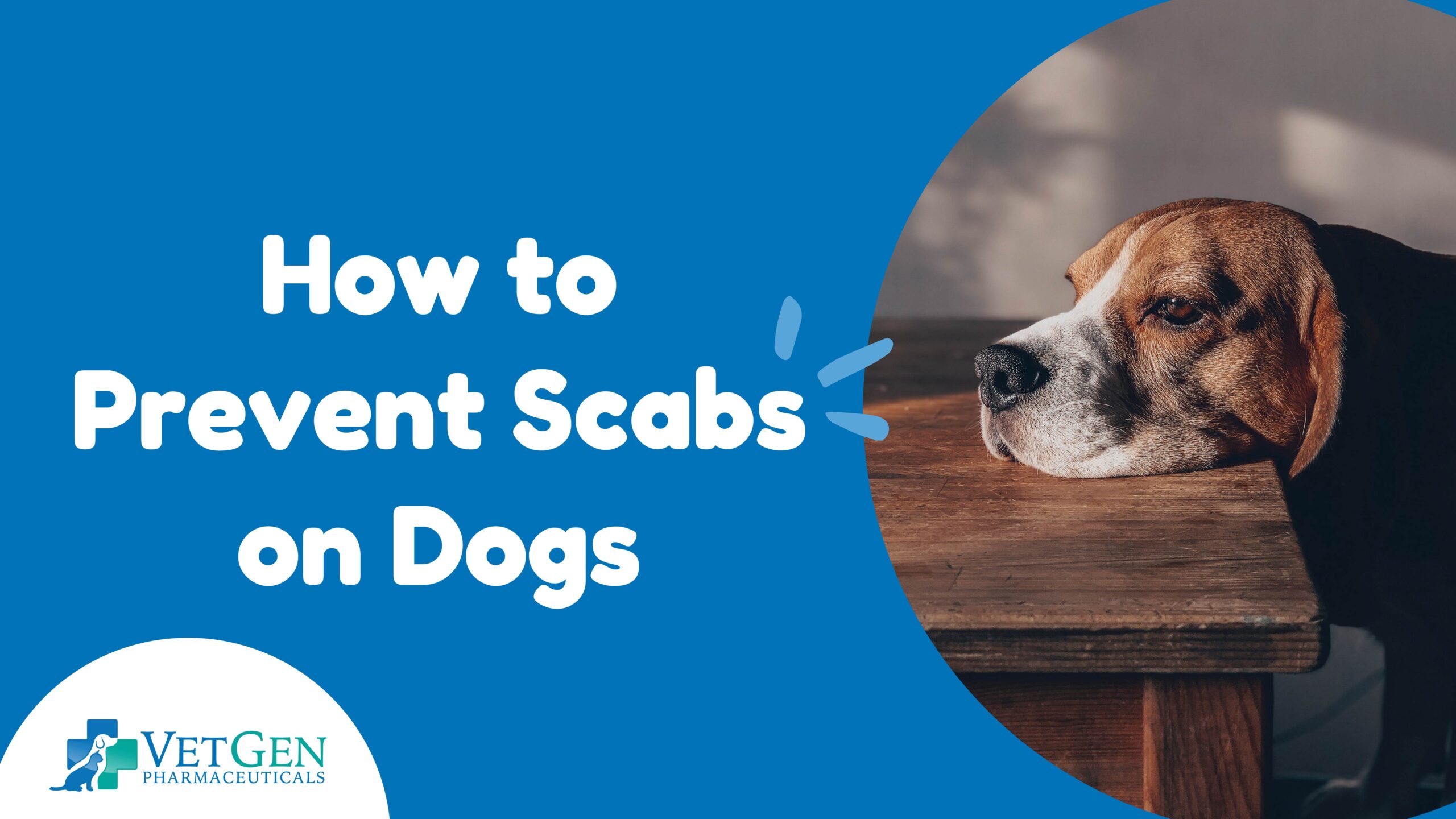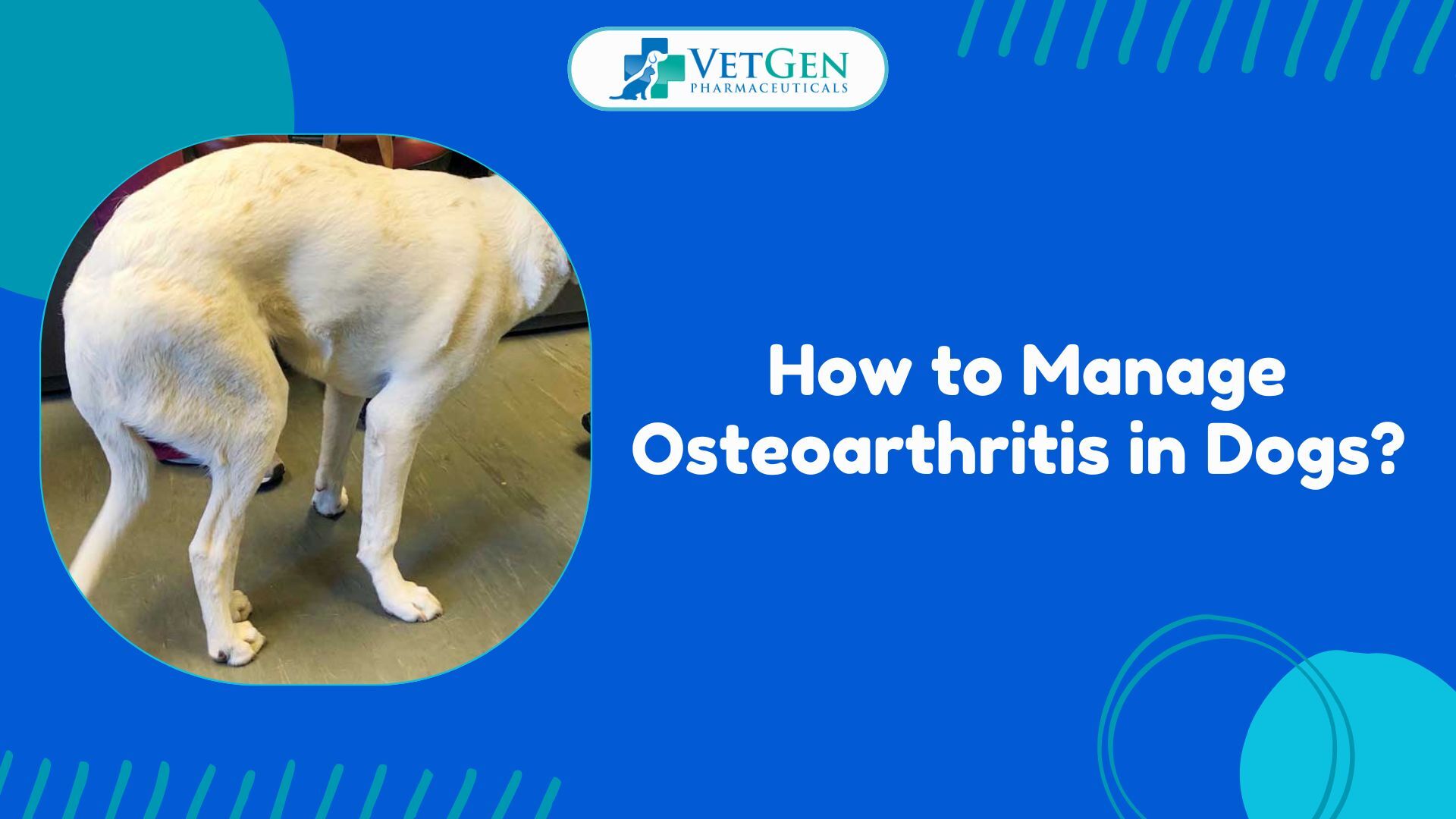You’re worried about ugly bugs often appearing on your dog’s back, aren’t you? Scabs are a common skin condition in dogs caused by many factors such as allergies, parasites or infections. Read more about environmental allergies in dogs.
This comprehensive blog will provide you with an understanding of different types of dog scabs, their causes and treatments and—most importantly—how to prevent them from occurring.
Key Takeaways
- Understand the different types of scabs on dogs, including allergic dermatitis, yeast infection scabs, folliculitis, impetigo, seborrhea, ringworm, mange (mites), fleas, and ticks.
- Take proactive measures to prevent external parasites like fleas and ticks from infesting your dog’s fur by regularly checking for them and using preventative products.
- Address any underlying health issues such as allergies or hormonal imbalances that can contribute to the development of scabs on your dog’s skin.
- Use hypoallergenic products to keep your furry friend’s skin clean and to maintain good hygiene.
What is a Scab?
A scab is essentially a natural bandage formed by your dog’s body. When the skin gets injured, platelets rush to the damaged area and clot to prevent bleeding. They create this crusty coating over the wound which acts as a shield, protecting it from bacteria and environmental irritants while healing takes place underneath.
In dogs, scabs can take different appearances depending on what generated them. Red scabs often indicate active bleeding, while other types might be a sign of internal issues like allergies or hormonal imbalances.
Types of Scabs on Dogs
Dogs can develop various types of scabs, including allergic dermatitis, yeast infection scabs, folliculitis, impetigo, seborrhea, ringworm, mange (mites), fleas, and ticks.
Allergic Dermatitis
Allergic dermatitis in dogs results from an allergic reaction leading to inflamed, itchy skin. It manifests as crusty and scaly patches that may eventually turn into scabs if not addressed promptly.
Yeast Infection Scabs
Yeast infection scabs are a common issue faced by many dogs. These crusty, black or red patches can often give your furry friend quite the itch. If you find yellow or raised marks on their skin while grooming them, your dog may have fallen prey to this affliction
Folliculitis
Folliculitis is a common cause of scabs on dogs. It occurs when the hair follicles become inflamed, leading to raised scabs on the skin. This condition can be caused by allergies, parasites, bacterial or fungal infections, and hormonal imbalances.
Impetigo
Impetigo is a skin condition that can cause scabs on dogs. It is often associated with bacterial or fungal infections. Dogs with impetigo may have red or yellow scabs on their skin.
Seborrhea
Seborrhea is one of the underlying conditions that can cause crusty scabs on dogs. It is a skin disorder characterized by itchy, dry skin with dandruff-like flakes. Dogs with seborrhea may also experience redness and inflammation, hair loss, and excessive scratching.
Ringworm
Ringworm is a common skin condition that can cause scabs on dogs. It is caused by a fungus called dermatophyte, and it can result in itchy patches and hair loss. Ringworm is contagious and can even be transmitted to humans (zoonotic).
Mange (Mites)
Mange (mites) is one of the types of scabs that can affect dogs, causing various symptoms such as crusty, black, raised, yellow, or red scabs. It is often associated with underlying skin conditions or internal disorders like allergies, parasites, bacterial or fungal infections, and hormonal imbalances.
Fleas
Fleas are a common cause of scabs on dogs. These tiny parasites can infest your dog’s fur and skin, causing intense itching and irritation. As your dog scratches and bites at the affected areas, it can lead to self-trauma and the development of scabs.
Ticks
Ticks are one of the main culprits behind scabs on dogs. These tiny parasites can latch onto your dog’s skin, causing irritation and leading to the formation of scabs. Tick infestations not only cause discomfort for your furry friend but can also transmit diseases such as Lyme disease and ehrlichiosis.
Types of Scabs on Dogs
Causes of scabs on dogs can include allergies, bacterial infections, external parasites, fungal infections, hormonal imbalances, immune disorders, nutritional issues, and yeast infections.
Understanding these causes is crucial for preventing and treating scabs on your furry friend. Read on to learn more!
Allergies
Allergies can cause scabs on dogs. When a dog is exposed to certain allergens, such as pollen or certain foods, it can lead to allergic reactions. These reactions can manifest as dermatitis, which is inflammation of the skin.
Bacterial Infection
Bacterial infections can cause scabs on dogs. These infections can lead to crusty, raised, red scabs that may be accompanied by itching and sores. Bacteria can enter the dog’s skin through wounds or inflammation, causing an immune response that results in scab formation.
External Parasites
External parasites, such as fleas, ticks, and mites, are common culprits behind scabs on dogs. These tiny creatures can cause skin irritation and intense itching in our furry friends. Fleas leave behind feces, saliva, and painful bites that can trigger allergic reactions in some dogs. Ticks not only inflict itchy bites but also have the potential to transmit infections if they become embedded in a dog’s skin.
Fungal Infection
Fungal infections are one of the causes of scabs on dogs. These infections can lead to the development of crusty scabs on a dog’s skin. If your dog has a fungal infection, you may notice itchy and irritated skin with redness or even rashes.
Hormonal Imbalance
An imbalance of the hormones can also contribute to development of skin lesions, such as scabs in dogs. If dogs’ hormones aren’t working properly, their skin can get dry, irritated and prone to itching and scratching.
Immune Disorders
Immune disorders can be one of the causes of scabs on dogs. These disorders, such as allergies or autoimmune diseases, can lead to underlying skin conditions or internal disorders that result in crusty scabs on your furry friend.
Nutritional Issues
Proper nutrition plays a crucial role in maintaining a dog’s skin health and preventing scabs. Nutritional issues can contribute to various skin conditions that may lead to scabs on dogs. Feeding your furry friend a high-quality diet helps provide the necessary nutrients to support their overall skin health. A well-balanced diet reduces the risk of nutritional deficiencies or imbalances that make dogs more susceptible to skin problems and scabs.
Yeast Infection
Yeast infections can lead to the formation of scabs on dogs. These infections occur when there is an overgrowth of yeast on the dog’s skin, usually in warm and moist areas such as between their toes or in skin folds.
Did you know that there’s another form of infection in dogs called Staph Infection?
Ticks
Ticks are one of the main culprits behind scabs on dogs. These tiny parasites can latch onto your dog’s skin, causing irritation and leading to the formation of scabs. Tick infestations not only cause discomfort for your furry friend but can also transmit diseases such as Lyme disease and ehrlichiosis.
Common Areas Where Dog Scabs Appear
Scabs on dogs can appear in various areas of their body. Here are the common areas where dog scabs often occur:.
- Belly and back: Scabs in these areas are usually caused by allergies, skin irritations, or itchy patches that lead to scratching behavior.
- Armpits and sides: Self-trauma from excessive scratching or licking can result in scabs forming in these regions.
- Ears: Ear infections may cause scabs to form on a dog’s ears. It is essential to check for any signs of infection if you notice scabs in this area.
- Nose: While less common, some dogs may develop scabs on their nose. The cause can vary and may require veterinary attention to determine the underlying issue.
Symptoms to Look For
Look out for color or texture changes, dry and flaky skin, acral lick granuloma, skin tumors, and hot spots on your dog.
Color or Texture Changes
Color or texture changes in the skin can be an important indicator of underlying health issues for dogs. If you notice any unusual coloration or texture on your dog’s skin, it could be a sign of a problem that needs attention.
Dry, Flaky Skin
Dry, flaky skin on dogs is a common symptom of various underlying skin conditions. It can be caused by allergies, parasites, infections, or hormonal imbalances. When your dog’s skin becomes dry and flaky, it may appear rough and scaly to the touch.
Acral Lick Granuloma
Acral Lick Granuloma is a condition that can cause scabs on dogs. This condition is characterized by excessive licking and scratching in a specific area of the dog’s body, leading to inflammation and the formation of irritated skin lesions.
Skin Tumors
Skin tumors are abnormal growths that can develop on a dog’s skin. These tumors can range from harmless to cancerous, and they may appear as scabs or other skin abnormalities. It’s important to pay attention to any scabs that persist or do not heal, as they could be a sign of underlying skin tumors.
Hot Spots
Hot spots are moist, irritated areas on a dog’s skin that can result in scabs. They are typically caused by excessive licking or chewing due to itching or irritation. Hot spots are more common in hot and humid climates, so it’s important to take precautions during these conditions.
Treatment for Scabs on Dogs
To treat scabs on dogs, use anti-bacterial or fungal dog shampoos, keep the home and yard clean to prevent infestations, brush the dog daily to remove dead skin cells, incorporate fish oil into their diet for healthy skin, use flea and tick collars to prevent parasites, provide a high-quality balanced diet, use safe grooming products, consider over-the-counter or veterinarian-prescribed medication as needed.
Anti-bacterial/Fungal Dog Shampoos
Color or texture changes in the skin can be an important indicator of underlying health issues for dogs. If you notice any unusual coloration or texture on your dog’s skin, it could be a sign of a problem that needs attention.
Using Fish Oil
Dry, flaky skin on dogs is a common symptom of various underlying skin conditions. It can be caused by allergies, parasites, infections, or hormonal imbalances. When your dog’s skin becomes dry and flaky, it may appear rough and scaly to the touch.
Safe Grooming Products
Safe grooming products play a crucial role in preventing and treating scabs on dogs. When it comes to keeping your furry friend’s skin healthy, using the right products is essential. Medicated shampoos can be recommended by veterinarians as part of the treatment for scabs on dogs. These specially formulated shampoos help fight bacterial and fungal infections, soothing your dog’s irritated skin.
Over Counter Medication
You can use over the counter medication to treat scabs on dogs. The specific type of medication will depend on the cause and severity of the scabs. It’s important to consult with a veterinarian before using any over the counter medication to ensure it is safe and appropriate for your dog. In some cases, vets may recommend over the counter pain medications to help manage inflamed or problematic scabs. Antibiotic ointments or creams may also be suggested by a vet for treating scabs on dogs.
Veterinarian Prescribed Medication
Veterinarian prescribed medication is an effective treatment option for dogs with skin conditions. These medications are specially formulated to target the underlying cause of scabs and promote healing. Whether it’s a bacterial or fungal infection, allergies, or other issues, your vet can prescribe the right medication to alleviate your dog’s discomfort and help their skin heal. These medications may come in the form of topical treatments that you apply directly to the affected area or oral medications that your dog takes by mouth.
How to Prevent Scabs on Dogs
Prevent scabs on dogs by using only hypoallergenic products, keeping them away from other dogs, avoiding humid environments, regularly checking for parasites, keeping their skin clean, and consulting the vet regularly.
Use Only Hypoallergenic Products
Using only hypoallergenic products is a crucial step in preventing scabs on dogs. These products are specifically formulated to reduce the risk of allergies and skin irritations in dogs. By opting for hypoallergenic dog shampoos, conditioners, and grooming products, you can ensure that your furry friend’s skin remains healthy and free from scabs. Hypoallergenic products are designed to be gentle on sensitive skin, making them ideal for dogs prone to allergies or those with existing skin conditions.
Keep Them Away From Other Dogs
Scabs on dogs can be contagious, which means they can easily spread to other dogs through direct contact. This is especially important to keep in mind if your furry friend has scabs. When dogs interact closely with each other, there is a risk of transmitting infections, allergies, and parasites that may be causing the scabs. To prevent this from happening, it’s crucial to keep your dog away from other dogs until their scabs have healed.
Avoid Keeping Your Dog in a Humid Environment
High humidity can contribute to the development of scabs on your dog’s skin. In fact, dogs living in humid climates may be more prone to scab formation. To prevent this, make sure to keep your dog in a dry environment. Regularly monitoring and controlling the humidity levels can go a long way towards preventing scabs and promoting overall skin health for your furry friend.
Regularly Check for Parasites
Regularly checking for parasites is crucial in preventing scabs on dogs. Parasites, such as mites, fleas, and ticks, can cause skin irritations and intense itching that lead to the formation of scabs.
Keep Your Dog’s Skin Clean
Veterinarian prescribed medication is an effective treatment option for dogs with skin conditions. These medications are specially formulated to target the underlying cause of scabs and promote healing. Whether it’s a bacterial or fungal infection, allergies, or other issues, your vet can prescribe the right medication to alleviate your dog’s discomfort and help their skin heal. These medications may come in the form of topical treatments that you apply directly to the affected area or oral medications that your dog takes by mouth.
Consult Vet Regularly
Consulting a vet regularly is crucial in preventing and treating scabs on dogs. Vets are trained to diagnose and treat various skin conditions and internal disorders that could be causing the scabs. Different types of scabs can indicate different health issues, and a vet can help identify the underlying cause. If your dog has itchy scabs, which are often associated with allergies, parasites, or infections, a vet can provide the necessary treatment.
Conclusion
In conclusion, preventing scabs on dogs involves a combination of proper hygiene, regular veterinary check-ups, and addressing any underlying health issues. By using hypoallergenic products, keeping them away from other dogs with possible infections, and maintaining clean skin, you can reduce the risk of scabs forming on your furry friend.
At VetGen Pharmaceuticals, we are dedicated and focused on enhancing the quality of your dog’s life to ensure your dog maintains an active lifestyle so you can enjoy each other’s company for many years to come! To this end, we offer the best dog supplements for dry skin and natural joint supplements for dogs. Each product offered by VetGen Pharmaceuticals is made from the best and safest ingredients.






